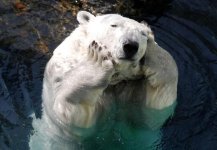Elixir
Made in America
Scientists Say They Could Bring Back Woolly Mammoths Within Two Years
... but can they save the elephants?
There are effects contemplated in the article such as:
Of course there will be unintended consequences as well. I feel pretty ambivalent about it - especially as a means to combat global warming...
... but can they save the elephants?
Ahead of the annual meeting of the American Association for the Advancement of Science (AAAS) in Boston this week, Professor George Church of Harvard University spoke about the progress his team has made over two years of trying to recreate the genetic blueprint of the long-extinct woolly mammoth. According to Church, a world-renowned geneticist, his team believes it can create a mammoth-elephant hybrid, with many of the recognizable woolly mammoth features, in embryo form within two years.
Since 2015, Church and his fellow scientists have been working to isolate the mammoth genes and splice them into the DNA of an Asian elephant, the closest living relative to the woolly mammoth. To do this, they are using a gene-editing technique known as CRISPR/Cas9, which Church helped develop.
There are effects contemplated in the article such as:
Reintroducing woolly mammoths, the scientists believe, would help slow the thawing of permafrost in this way. “They keep the tundra from thawing by punching through snow and allowing cold air to come in,” Church explained. “In the summer they knock down trees and help the grass grow.”
Of course there will be unintended consequences as well. I feel pretty ambivalent about it - especially as a means to combat global warming...



